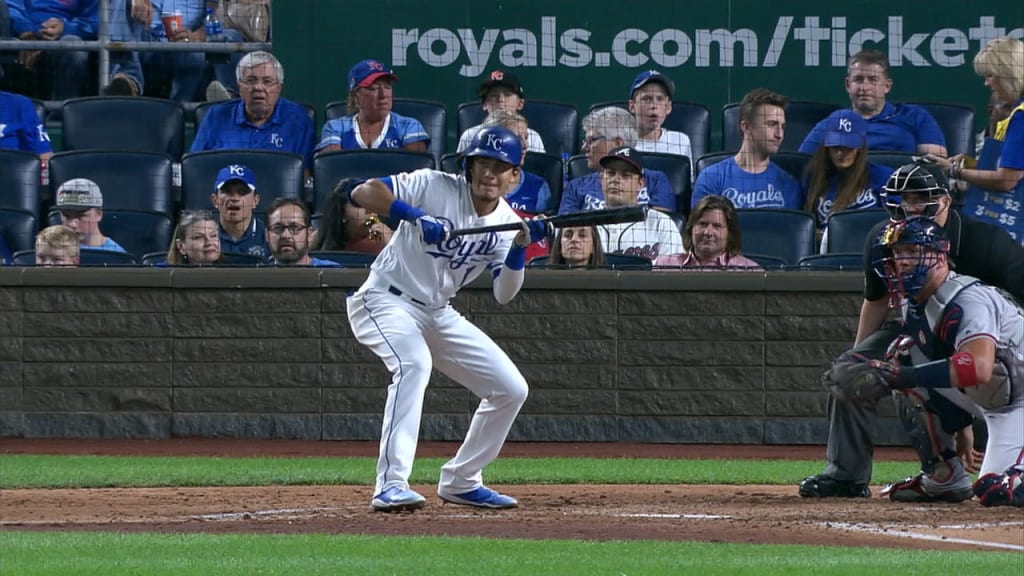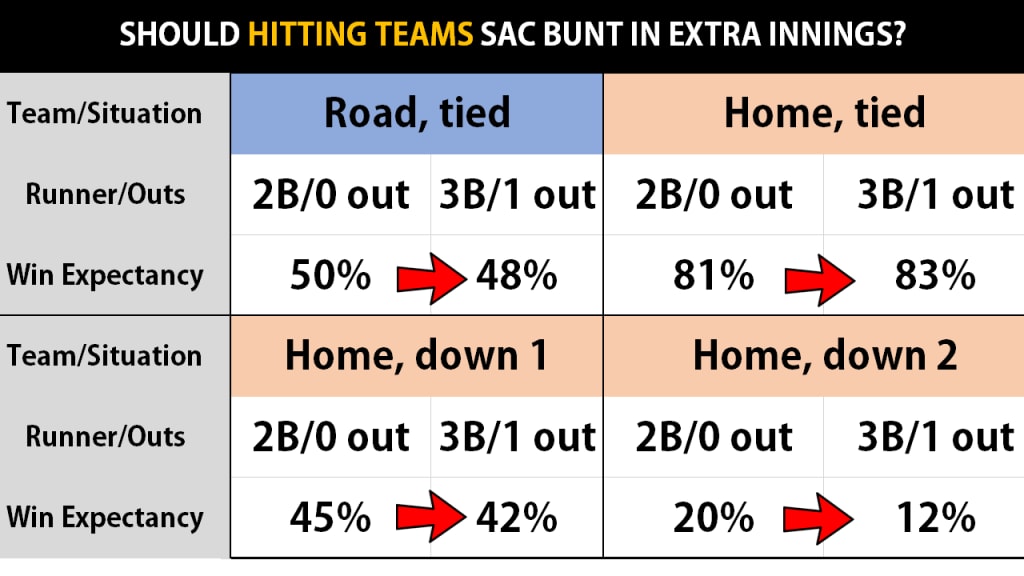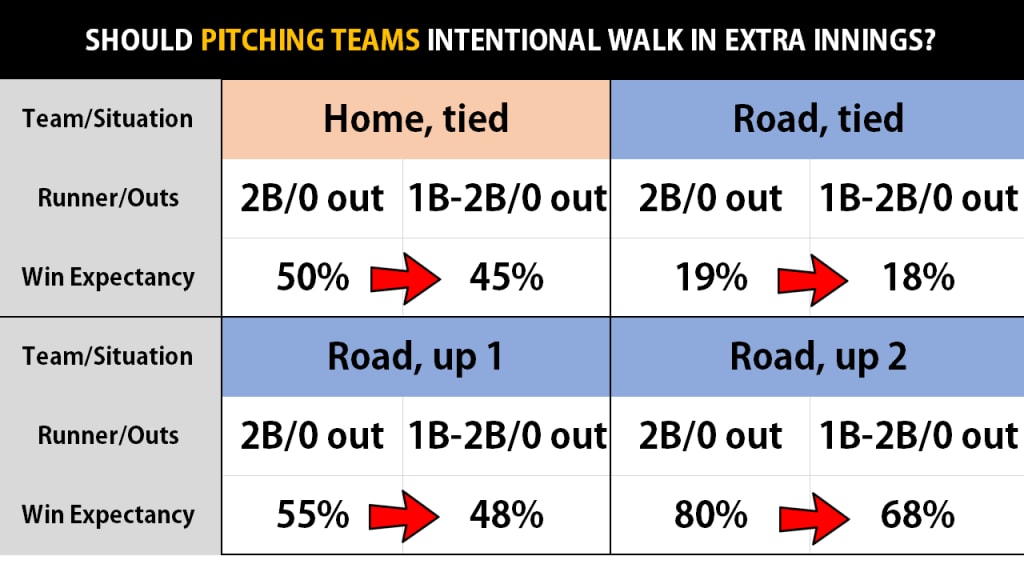
There's a divisive new rule coming to Major League Baseball in 2020, and it's not the designated hitter being added to the National League. (Well, it's not just that.) No, the new rule that's really going to stir up some controversy is that in extra innings, a "designated runner" will start on second base in each inning. That's the big one.
The reasoning behind it is clear: In a short 60-game season, and with pitchers who are going to enter the year with anything but a traditional Spring Training to stretch out, there's value in preventing exceptionally long extra-innings affairs that exhaust pitching staffs and keep players and staff at the park for extra hours in the time of a pandemic. It costs something, too, because there's beauty in how weird some of those never-ending games can get, but obviously, these aren't normal times.
We're not here today to argue about whether you'll like it or not; that's an aesthetic choice. What's more interesting is how this affects strategy, because Major League managers have never had to deal with this aspect of things before. For example, are hitting teams just going to immediately call for the sacrifice bunt each time? That's a real concern, and not a welcome idea from an entertainment perspective. Will pitching teams always just call for the intentional walk to set up the double play? Should they?
Fortunately for us, we've got a few ways to answer those questions. We can see what theoretically should happen (looking at Major League run expectancy charts in various situations) and we can see what did happen (given that the Minor Leagues has had this rule in place for the last two seasons).
Let's compare the two, and come up with a strategy looking forward.
But first ...
1. Is this going to get games resolved more quickly?
Well, it better, right? This is the entire point. If not, what are we even doing here? It seems like it does.
As reported by Baseball America's JJ Cooper, 45 percent of Minor League games in 2016-17 (the final two years without the runner) ended after one extra inning ... and 73 percent of them ended after one extra inning in 2018-19 (with the runner). There were 133 games in 2016-17 that went 13 innings or longer ... and just five in 2018-19. Those are huge differences.
So, sure, it does seem like it achieves the intended goal. You won't see as many extra-inning games that become a home run derby, waiting for someone to run into that walk-off homer in the 16th inning. That's simple enough, and relatively non-controversial; you may not like what it does, but at least it seems likely to do what it's expected to.
Reds manager David Bell, for one, sounds excited about it, as he explained to MLB.com's Mark Sheldon on July 2.
“That, in my opinion, will be a great rule," said Bell. "Two years ago, when I was with the Giants [as player development director], I was sitting there in the stands watching Minor League games. I was rooting for extra innings because it was so exciting. You get to see all of this strategy happen in one inning. You know you’re not going to be there all night. You have a pretty good idea of when it’s going to end. I think the fans are going to love it. I think it’s a great rule. Hopefully, it will be a success and we can stay with it.”
Maybe so. But what about strategy? How should the two sides play this? Are we really doomed to endless sacrifice bunts?
2. For the hitting team: Is a sacrifice bunt a good idea?
Well, that depends. Is a runner on third with one out better than a runner on second with no outs? Who's hitting and pitching? And, most importantly, are you the home team or the road team?
If you're the home team in a tied extra-inning game, one run is enough to win, no matter how you get it. But if you're the road team, you can't simply assume one run will be all you'll need -- you still need to defend that lead in the bottom of the inning, and larger leads are obviously better. And if you're the home team down by multiple runs, you really don't want to give up one of your three outs.
All of this makes home vs. road an important difference; think of this like how it works in overtime in football, where the team that gets the ball second already knows if it needs to match a field goal or force a touchdown, and can then plan accordingly. Strategically, it's a big deal, so we'll have to break this out separately.
Either way, no one, it should go without saying, wants this rule to drastically increase the rate of sac bunts in extra innings.
"I was afraid this would be the case when the rule was implemented," tweeted Alex Freedman, broadcaster for the Triple-A Oklahoma Dodgers, "but you don’t see it too much. It became apparent pretty quickly that playing for one run in the top of an inning usually backfires."
"One run by visiting team is usually not enough to win the game," tweeted El Paso's Tim Hagerty, who added he'd seen fun quirks like a "leadoff two-run homer."
So maybe this won't play out as everyone fears it will. What do the numbers say?
In the Majors, the numbers say ...
For this, we'll rely on work MLB.com senior data architect Tom Tango has produced, taking the traditional win expectancy charts (based on how often teams historically win based on inning, score, runners on, base and outs) and updating them to include a runner starting on second in each extra inning. Let's split the teams home and away, and see how they might be expected to do in the most likely game situations. (The run expectancy data includes every season from 1960 through 2010, so it's an extremely large sample that covers a wide range of run-scoring environments.)

The takeaway here should be ... well, not much happens, especially for the road team. The odds of winning drop slightly, mostly because this move, even if successful, doesn't guarantee a run on the board -- and even if it did, one run doesn't end the game, since the home team can still score multiple runs. Put another way, with a runner on second and no outs, teams in 2019 scored an average of 1.15 runs. With a runner on third and one out, teams scored an average of .95 runs. That is, obviously, worse.
The odds go up slightly when the home team is tied -- that makes sense, since a single run ends the game, in a way that isn't true for the visitors -- and they go down if the home team is losing by one run, which also makes sense. (Don't bunt if you're down by multiple runs, home team. Don't.)
But -- and this is important -- even this is not the full picture, because all we showed there is the difference between 2B/0 outs and 3B/1 out. That assumes managers simply get to make that choice. They do not.
Another way of saying that is that sacrifice bunt attempts are not guaranteed to succeed, which is hugely important and yet too easily forgotten. (One study from 2016 suggested that "sacrifice bunts typically are successful about 70-80 percent of the time." Last week, Ben Clemens at FanGraphs wrote that 15 percent of the time "it's a disaster," which tracks with the 2016 study well.) You might want to turn 2B/0 out into 3B/1 out ... and yet you might get the lead runner caught, or worse, a double play.
In the Minors, the outcomes were ...
That was fun enough to dig into the math, but we've also got some real-world outcomes to check into, since we've seen this for two full Minor League seasons.
(Let's confirm one thing here, which is that for the Minors, we're counting any extra-inning game, not just the 10th inning and beyond. If that sounds confusing, it's because in the Minors, doubleheaders are played as seven innings apiece, so there are a handful of games where the eighth inning is the first extra inning. Weird!)
In 2018-19, there were nearly 3,000 extra-inning games. How many bunts did we see in the first plate appearance?
• Visiting team bunted to start their inning 22 percent of the time
• Home team, when tied, bunted to start 31 percent
• Home team, when behind, did so 13 percent of the time
Setting aside what in the world the home team was thinking with those "bunt while losing" ideas -- perhaps a particularly weak hitter was up -- this shows two things. First, that the tied home team bunted more than the road team is strategically correct, and aligns with our numbers above. Second, this just isn't a huge number of bunts! More than three-quarters of the time, the visitors didn't bunt to start their inning. More than two-thirds of the time (when tied), the home team didn't bunt.
How much did this help?
• When the visiting team led off with a bunt: 47 percent win
• When the visiting team did not lead off with a bunt: 50.1 percent win
Not much. So if you're worried about insta-sac-bunt-ball ... maybe don't be. It didn't happen in the Minors.
So the tactic should be ...
The sac bunt doesn't add that much value, and sometimes subtracts -- if you're even successful in getting it down, anyway. The visiting team should almost never bother, unless their hitter is extremely weak (and capable of bunting). If the home team is down by one run, they probably shouldn't; if they're down by multiple runs, they really shouldn't.
Now: if you're the home team, and if it's tied, and if your hitter is not a strong hitter -- you're never, ever bunting with Mike Trout or Christian Yelich, obviously -- and if you think he's likely to lay down a good bunt, then maybe consider it. Otherwise? Nah.
3. For the pitching team: Is the intentional walk a good idea?
We can do this from the other side, too. Should the pitching team send the leadoff hitter down to first, setting up a force at three bases and a potential double play? Again, the quality of the hitter matters a lot here, but we'll stick with overall numbers, and also see what the Minors did.
In the Majors, the numbers say ...
This is a little different than the sac bunt, because while that is not guaranteed to work and might fail, the intentional walk is of course a simple choice.

There's not much here. Walking the first man of the top of the inning doesn't help and might actually hurt; sure, you might get that double play, but you've also put on another runner to increase the lead. Doing it in the bottom of the inning in a tie game is somewhat irrelevant, but the road team would significantly hurt their chances if they did it in a game where they took a lead of one or more runs into the bottom of the frame. That seems obvious enough -- don't put the tying or go-ahead run on base!
In the Minors, the outcomes were ...
This just about never happened. Remember we said nearly 3,000 extra-inning games over the last two seasons? The home team issued an intentional walk to start the top of an extra inning 12 times. The road team, when on the mound, did so in a tie game 130 times. Combined, that's just under 5 percent of opportunities. (The road team correctly never issued an intentional walk when they carried a lead. Good job, road teams.)
So the tactic should be ...
Don't bother, probably? Again, there are exceptions. Maybe your pitcher is an extreme ground baller, and the batter is, too. Maybe the leadoff hitter is a superstar, on the level of a Trout or a Yelich, and the following hitters are far weaker. But for the most part? This isn't it.
In baseball, as in life, it seems tempting to do something, in this case to order a sac bunt attempt or an intentional walk. In some specific cases, maybe that makes sense. But overall, it seems like the best thing to do is to do nothing. The best thing to do is to let players play baseball. That's what we saw in the Minors, and that's likely what we'll see in the Majors.
